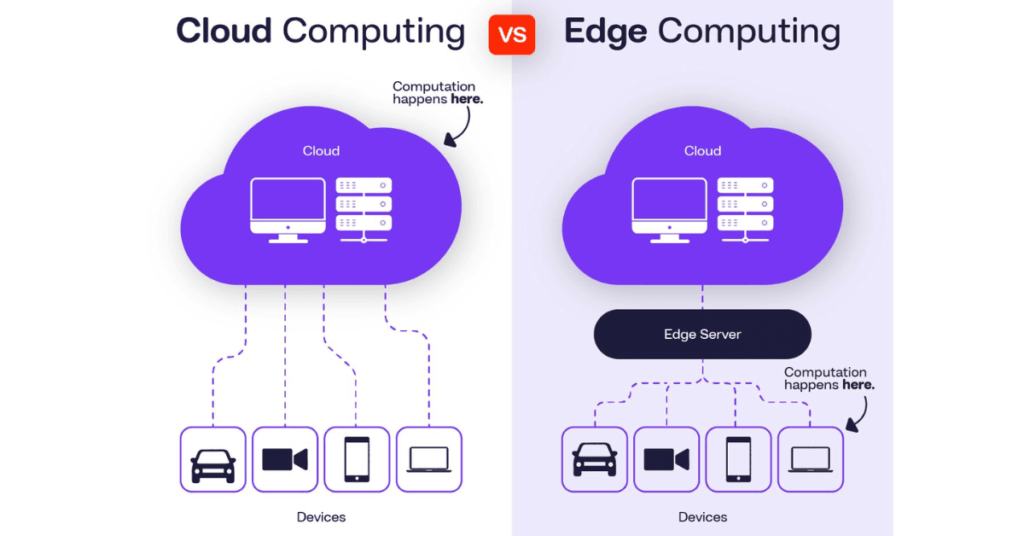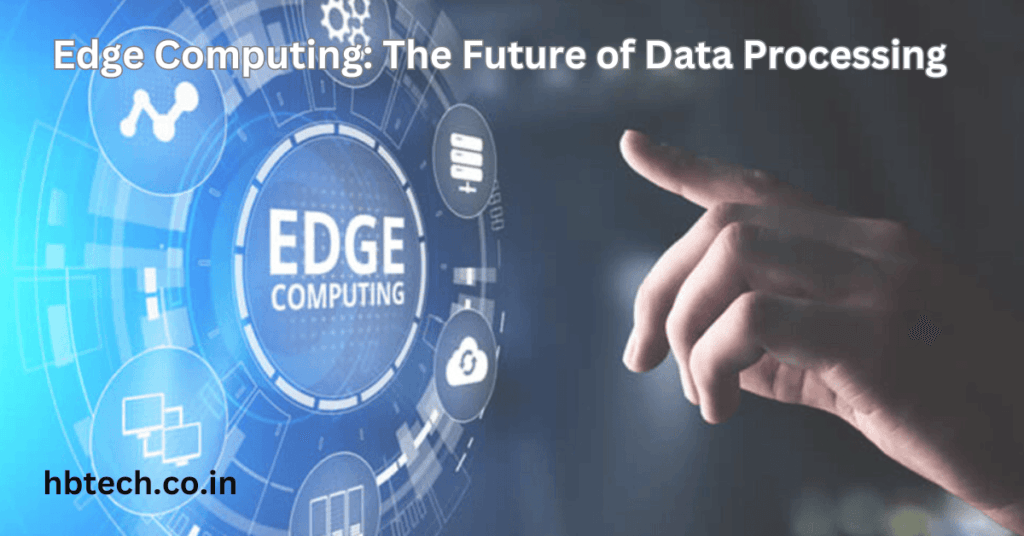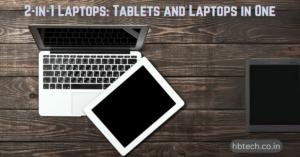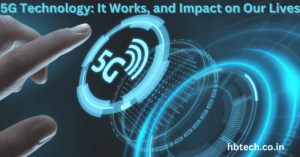With so many devices connecting to the internet, managing and processing all this data quickly is more important than ever. Edge computing is a new way to handle data processing that makes things faster and more efficient by moving the work closer to where the data is generated .
Edge Computing
Edge computing means handling data processing closer to its source, like on local devices or nearby servers, instead of sending everything to a central cloud server far away.
For example, if a smart security camera detects motion, it could process the video right there rather than sending everything to a cloud server first. By working on the “edge” of the network, closer to the actual device, edge computing reduces delays and keeps things running smoothly.

How Edge Computing Works
In edge computing, data is collected from devices called “edge devices” such as sensors, camera or even smartphones. Instead of sending all this data to a centralized cloud, edge devices process it locally.
- Data is Collected: Devices like sensors or cameras capture data in real time.
- Local Processing: Instead of sending every detail to the cloud , the data is processed on-site or on a nearby server.
- Filtered Data Sent to the Cloud: Only necessary information is sent to the cloud for more complex analysis or for long-term storage, reducing data traffic
This setup combines the benefits of cloud computing and local processing, giving fast responses when needed and handling bigger tasks in the cloud when possible.
Edge Computing vs Cloud Computing

In cloud computing, data is sent to centralized data centers (often far from the user) where it is stored, processed, and managed. This centralized model works well for application that don’t require immediate feedback and can handle large volumes of data , But it can lead to delays since data has to travel back and forth.
Edge computing, by contrast, processes data close to where it’s generated such as on local devices or nearby servers. This edge location reduces latency by minimizing the distance data must travel, making it ideal for applications that need real-time processing, like autonomous vehicles, wearable health monitors and smart home devices. By handling critical data locally , edge computing can respond faster than cloud computing, while still allowing non-urgent data to be sent to the cloud for storage or deeper analysis.
Benefits of Edge Computing
Edge computing is helpful in several ways :
- Faster Response Time
With data processed near its source, systems respond much faster than if data had to travel to a cloud server and back. This is especially important for activities that need quick reactions, like monitoring health data or controlling self-driving cars. - Reduced Bandwidth Usage
By processing data on local devices, there’s less need to send large amounts of data back and forth over the internet, which saves bandwidth. For example, a security camera doesn’t need to send all its footage to the cloud just what’s relevant , like when motion is detected. - Better Privacy and Security
With data processed closer to its source, there’s less risk of data exposure. Only critical data gets sent to the cloud, which reduces the chances of sensitive information being compromised. - Easy to Scale
Edge computing allows new devices to be added without overloading a central cloud server. The processing power is spread out among devices , making it easier to expand systems as more devices connect. - Improved Reliability
Since edge devices can work independently, they don’t rely as much on the network. If the internet connection goes down, edge devices can continue to operate and make decisions on their own. This is useful for critical systems like medical devices or industrial equipment
How Edge Computing is Used in Different Industries
Edge computing has a wide range of applications and few examples of where it’s making a difference:
- Healthcare
Wearable health devices, like heart monitors, collect data in real time. With edge computing, these devices can process and respond to data on the spot. For example , if a patient’s heart rate spikes, the device can send an instant alert to healthcare providers. - Manufacturing
In manufacturing, sensors on equipment can detect performance issues early on. Edge computing helps process data on-site, so manufacturers can catch issues before they lead to costly downtime, improving quality and efficiency. - Retail
Edge computing powers “smart” stores with sensors that track inventory, monitor foot traffic and manage stock. This real-time processing helps stores respond quickly to trends, manage shelves and improve the customer experience. - Transportation
Self-driving cars rely on edge computing to process data in real time, helping them respond quickly to changes on the road. This makes autonomous vehicles safer, as they don’t need to wait for cloud servers to analyze data and make driving decisions .
Challenges and the Future of Edge Computing
While edge computing offers many benefits, it comes with its own challenges. Managing multiple devices and keeping data secure at the edge requires careful planning. Each device could be a target for cyber threats, so strong security is essential. Setting up and maintaining edge devices also takes time and resources.
Looking ahead, edge computing is expected to keep growing, especially as faster 5G networks become more widespread. Technologies like artificial intelligence (AI) will make edge devices even smarter, allowing them to process more complex data at the source.
Edge computing brings data processing closer to where it’s needed, creating faster, more reliable systems for everything from healthcare to autonomous vehicles. By combining local processing with the cloud, edge computing improves efficiency, saves bandwidth and boosts privacy. As technology advances, edge computing is set to play an even bigger role in helping devices respond in real time, making our connected world faster, smarter and more secure.
Frequently Asked Questions(FAQs)
What is edge computing?
Edge computing refers to the practice of processing data closer to the source of data generation, such as on local devices, sensors, or servers, instead of sending it to a faraway data center for processing.
How is cloud computing different from edge computing?
Cloud computing processes data in centralized data centers over the internet, while edge computing processes data locally at or near the data source. This makes edge computing faster and reduces latency, whereas cloud computing offers scalability and centralized management.
Which one is faster, edge computing or cloud computing?
Edge computing is faster because it processes data locally, reducing the time it takes to send data to remote data centers. This is known as low latency. Cloud computing may experience delays due to the distance data must travel.
What are the advantages of edge computing?
Edge computing offers:
Faster processing with low latency, ideal for real-time applications.
Bandwidth efficiency, as only essential data is sent to the cloud.
Local processing , which is great for time-sensitive tasks like autonomous vehicles or industrial IoT devices.What are the benefits of cloud computing?
Cloud computing provides:
Scalability, allowing businesses to easily increase or decrease their computing resources.
Cost-effectiveness, with pay-as-you-go models and no need for large upfront investments
Centralized control and management of large systems and data.Can edge computing and cloud computing work together?
Yes! Edge and cloud computing can complement each other. Edge computing handles quick, local processing, while cloud computing can handle heavy-duty tasks like data storage and complex analytics, making the system more efficient overall.
What types of applications are best suited for edge computing?
Edge computing is ideal for real-time applications where immediate decisions are needed, such as autonomous vehicles, industrial IoT (smart factories) and health-monitoring devices.
Related Posts
- 2-in-1 Laptops: Tablets and Laptops in One
- 5G Technology: What It Is, It Works and Impact on Our Lives
- 8K Gaming on a Laptop: Is It Worth It?
- A Simple Guide to Remote Work: Work from Anywhere, Anytime
- A Visit to the Museum of Jurassic Technology
- Affordable AI Solutions for Small Businesses









